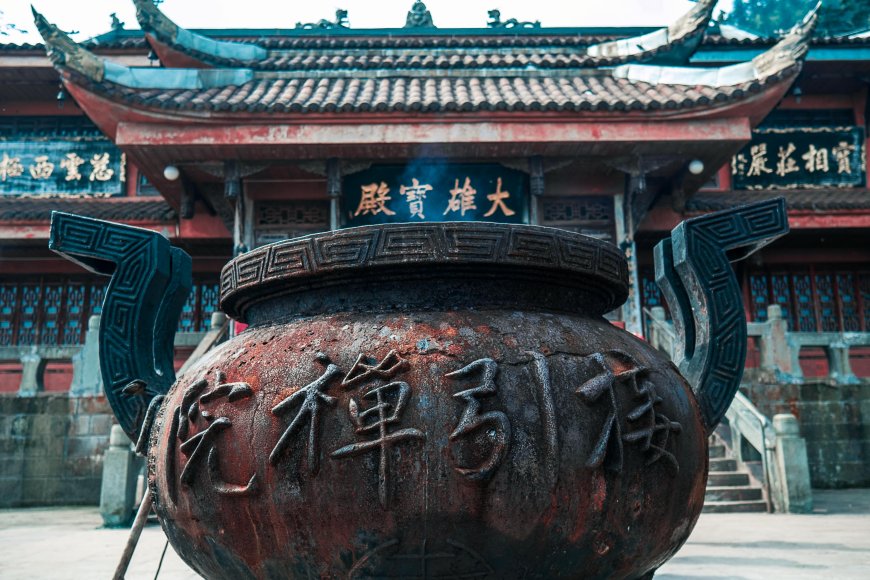Get to know ancient Chinese beliefs
Exploring ancient Chinese beliefs is an exciting journey through time, delving into the depths of philosophy and spirituality that have woven the threads of Chinese culture throughout the ages. Through studying these beliefs, we discover a rich cultural heritage that includes vital energy ('qi'), the philosophy of balance ('yin and yang'), self-defense arts like 'Tai Chi,' and much more.

Exploring ancient Chinese beliefs is an exciting journey through time, delving into the depths of philosophy and spirituality that have woven the threads of Chinese culture throughout the ages. Through studying these beliefs, we discover a rich cultural heritage that includes vital energy ('qi'), the philosophy of balance ('yin and yang'), self-defense arts like 'Tai Chi,' and much more.
Get to know ancient Chinese beliefs
Exploring ancient Chinese beliefs is a journey through a long and rich history of philosophy and spirituality that has shaped Chinese civilization over the ages. Understanding these beliefs is essential to comprehend Chinese culture and its influence on society, arts, and sciences.
At its core, ancient Chinese beliefs revolve around balance and harmony between opposing elements and interpreting the world through energy and flow. These beliefs manifest in several fundamental concepts, including "Qi," the concept of vital energy that flows throughout the universe and maintains balance. Additionally, the principle of "Yin and Yang" is crucial to understanding Chinese beliefs, symbolizing the balance between opposing forces such as darkness and light, feminine and masculine, negative and positive.
Ancient Chinese beliefs also encompass various religions such as Taoism and Confucianism, which offer different perspectives on life, ethics, and wisdom. Moreover, ancient Chinese beliefs include a range of profound philosophies addressing topics such as human wisdom, education, and political governance.
Exploring ancient Chinese beliefs serves to interpret the spiritual and philosophical foundations that shaped Chinese civilization, providing a deep understanding of its values and beliefs that continue to have a significant impact on contemporary Chinese culture and the global stage.
The roots of ancient Chinese beliefs
The roots of ancient Chinese beliefs trace back to ancient times and intertwine with the development of Chinese civilization throughout the ages. These beliefs are characterized by their diversity and multiple sources, making tracing their roots a necessary task to understand Chinese culture and philosophy.
Ancient Chinese beliefs are distinguished by diverse influences, blending the original beliefs of indigenous peoples of China with the cultural and religious influences of peoples coming from the north and west. In this context, the ancient roots of Chinese beliefs can be found in myths and ancient religions that emerged in prehistoric periods, focusing on elements of nature, gods, and spirits.
Over time, ancient Chinese beliefs evolved through cultural and historical interactions, as imported religions such as Buddhism and Taoism introduced new elements into Chinese culture, influencing patterns of thought and popular beliefs.
Among the most significant roots from which ancient Chinese beliefs emerged are Taoism and Confucianism. Taoism focuses on the concept of "Tao" or "the way" as an eternal force and fundamental principle of everything in the universe, while Confucianism emphasizes ethical values, education, and wisdom, striving for personal and social balance, success, and harmony.
The roots of ancient Chinese beliefs reflect a long history of evolution and diverse influences, forming the foundation of contemporary Chinese culture and philosophy.
Vital energy and balance
In ancient Chinese beliefs, vital energy plays a fundamental and central role, considered one of the most important concepts that constitute an integral part of ancient Chinese culture. The universe is believed to be filled with vital energy, known in Chinese as "Qi" or "Chi," which is seen as a living force flowing throughout the cosmos, giving life to everything.
Vital energy "Qi" embodies the idea of balance and harmony in the universe, where ancient Chinese belief holds that health and happiness depend on the balance of energy flow in the body and mind. To achieve this balance, many ancient Chinese practices such as physical exercises like Tai Chi, Qigong, and yoga, as well as spiritual techniques like meditation and yoga, are adopted.
Additionally, the principle of "Yin and Yang" is fundamental in understanding balance in ancient Chinese beliefs. "Yin and Yang" represent the idea of balance between opposing and complementary forces in the universe, such as darkness and light, feminine and masculine, negative and positive. Ancient Chinese belief holds that the balance between these forces leads to well-being, happiness, and health.
Overall, vital energy and the concept of balance in ancient Chinese beliefs embody a comprehensive vision of life and the universe, reflecting a deep concern for physical, mental, and spiritual health, forming the basis for the philosophy of life and nature among the Chinese people since ancient times.
The ancient religions of China
The ancient religions of China form an important part of ancient Chinese beliefs, reflecting a rich and diverse religious heritage that influences the culture and daily life of the Chinese people. Ancient Chinese religions can be classified into several main types, including:
1. Taoism (Daoism): Taoism is considered one of the oldest religions in China, founded on the concept of "Tao" or "the Way," which expresses the eternal force and universal principle governing the entire cosmos. Taoism focuses on balance, tranquility, tolerance, and encourages harmony with nature and the principle of non-action.
2. Confucianism: Founded on the teachings of the Chinese philosopher Confucius, Confucianism emphasizes ethics, education, and wisdom. It includes values such as loyalty, respect, honesty, and justice, seeking to achieve balance and social prosperity by providing guidance and advice to rulers and citizens.
3. Buddhism: Introduced to China from India, Buddhism became an important part of Chinese religions. Buddhism focuses on achieving enlightenment and liberation from the cycle of birth and death, promoting compassion, empathy, and inner balance.
4. Folk Religion: Folk religion is associated with ritual beliefs and superstitions, believing in the existence of spirits, ghosts, and malevolent entities, and seeking protection from them through religious traditions and rituals.
These ancient Chinese religions reflect the diversity of beliefs and religious pluralism in China, demonstrating their profound influence on the culture, philosophy, and daily life of the Chinese people.
The ancient religions of China
The ancient religions of China constitute an essential part of ancient Chinese beliefs, having evolved and formed over millennia to become an integral part of Chinese culture and history. The history of ancient Chinese religions dates back thousands of years and has been represented in a variety of beliefs and religious practices that reflect a rich and diverse spiritual heritage in China.
One of the main religions in ancient China is Taoism, which is considered one of the oldest philosophical and religious systems in the world. Taoism focuses on the concept of Tao (Dao), or "the Way," representing the eternal force and universal principle flowing through all things. Taoism emphasizes the importance of balance and harmony with nature and the cosmos, encouraging non-resistance and peaceful interaction with change.
In addition to Taoism, Confucianism had a strong influence on ancient Chinese culture. Founded on ethical and philosophical principles, Confucianism emphasizes fulfilling social and moral duties and achieving balance and harmony in society. Confucianism promotes mutual respect, appreciation, and the teaching of virtue and wisdom.
Furthermore, Buddhism played a significant role in ancient Chinese religions, representing the religious philosophy focusing on achieving enlightenment and liberation from the cycle of birth and death. Buddhism encourages tolerance, compassion, and inner balance, and is considered one of the important religions that influenced Chinese culture and philosophy.
The ancient religions of China demonstrate diversity and plurality in religious and spiritual beliefs that have shaped Chinese culture over the ages, reflecting fundamental values such as balance, harmony, and peaceful coexistence.
The impact of ancient Chinese beliefs on modern culture
Modern culture has been greatly influenced by ancient Chinese beliefs, as these beliefs extend deep into Chinese thought and form the basis for thinking, behavior, and traditions in contemporary Chinese society. This influence is evident in several aspects of modern culture
1. Arts and Literature: Modern Chinese arts and literature reflect many ancient Chinese concepts and values, such as balance, harmony, and natural aesthetics. This is evident in famous artworks and literary works that express traditional Chinese concepts and draw inspiration from them.
2. Philosophy and Social Sciences: Ancient Chinese beliefs influence modern philosophy and social sciences in China, where scholars and philosophers study and discuss ancient Chinese beliefs in contexts such as ethics, human behavior, and societal development.
3. Traditional Chinese Medicine: Traditional Chinese medicine is an integral part of ancient Chinese beliefs, based on understanding vital energy (Qi) and the principle of balance and harmony between elements. Traditional Chinese medicine and practices have proven their effectiveness and impact in modern medical treatment.
4. Religion and Religious Rituals: Ancient Chinese religious beliefs appear in many religious rituals and celebrations that blend with everyday life, such as the Spring Festival, Qingming Festival, and various traditional family rituals.
5. Leadership and Political Governance: Ancient Chinese thought influences leadership and political governance in modern China, where authority relies on concepts of righteous governance and balance and harmony between the ruler and the people.
The influence of ancient Chinese beliefs on modern culture can be seen in all aspects of Chinese life, and these beliefs remain an integral part of China's cultural and historical identity.
The concept of balance in ancient Chinese beliefs
Balance is considered a fundamental concept in ancient Chinese beliefs, where maintaining equilibrium between opposing forces is believed to contribute to cosmic harmony, inner peace, and personal development. These beliefs manifest themselves in various aspects of Chinese culture, ranging from philosophy to medicine, arts, and even politics. Here are the details
1. Ancient Chinese Philosophy: Philosophies like Taoism and Confucianism emphasize the importance of balance. Through the concept of "Yin and Yang," balancing opposing forces such as darkness and light, female and male, negative and positive is considered essential for maintaining cosmic harmony and inner happiness.
2. Traditional Chinese Medicine: Balance between vital energy "Qi" and the five natural elements (wood, fire, earth, metal, water) is considered crucial for good health and inner peace. Any disturbance in this balance is seen as a source of physical and psychological problems.
3. Eastern Martial Arts: Eastern martial arts like Tai Chi, Qigong, and Chinese yoga reflect the concept of balance between body, mind, and spirit. These practices encourage achieving inner balance, tranquility, and peace through gentle movement and deep breathing.
4. Traditional Arts and Crafts: Concepts of balance are evident in traditional Chinese arts such as painting, sculpture, and ceramics, where artists strive to achieve balance and harmony in the coordination of various elements to produce beautiful and harmonious artworks.
5. Politics and Governance: In politics and governance, concepts of balance and harmony are fundamental to achieving stability and social peace. Maintaining balance between opposing forces and achieving harmony between the ruler and the people are considered essential for sound governance.
Balance is a foundational concept in ancient Chinese beliefs, serving as the essence for maintaining cosmic harmony, inner peace, and personal and social prosperity.
The Arts of Life
The arts of life in ancient Chinese culture represent a comprehensive approach to daily living, encompassing a diverse range of practices and techniques rooted in ancient Chinese beliefs aimed at achieving balance and inner happiness. Considered an integral part of traditional Chinese culture, the arts of life have been developed over the ages by Chinese philosophers, sages, and teachers.
1. Tai Chi and Qigong: Tai Chi and Qigong are important components of ancient Chinese arts of life. Stemming from Taoist philosophy, these practices focus on guiding and regulating the flow of life energy (chi) within the body through flowing movements, deep breathing, and serene meditation.
2. Meditation and Yoga: Ancient Chinese arts of life also include practices of meditation and yoga, which help calm the mind, enhance focus, and increase awareness. These practices rely on concepts of balance, harmony, and inner concentration to achieve inner peace and balance of body and mind.
3. Tea Arts: Tea drinking ceremonies are an essential part of Chinese culture, blending artistry with spirituality. The preparation and presentation of tea are considered an art that requires concentration, precision, and attention to detail, with enjoying tea being an experience that combines relaxation, social interaction, and contemplation.
4. Ornamentation and Interior Decoration: Chinese arts of life also encompass the arts of ornamentation and interior decoration, reflecting concepts of balance and traditional Chinese architectural design. Coordinating furniture, colors, and decorations is considered an art that expresses cultural identity and enhances balance and tranquility in the home.
5. Martial Arts and Self-Defense: Ancient Chinese arts of life also include traditional self-defense arts such as Kung Fu, which focus on developing physical and spiritual strength, as well as improving balance and harmony between body and mind.
The arts of life in ancient Chinese culture reflect profound concepts of balance, harmony, and spirituality, forming an essential part of both traditional and modern Chinese lifestyles.
Summary
Ancient Chinese beliefs are considered fundamental aspects of Chinese culture and history, constituting a collection of philosophies, religions, and practices that reflect a rich and diverse heritage. These beliefs are characterized by a focus on concepts such as balance, harmony, spirituality, and wisdom. Ancient Chinese beliefs have deep influences on various aspects of Chinese life, ranging from philosophy to arts, medicine, and politics. Serving as a key to understanding Chinese identity and culture, these beliefs continue to play a vital role in contemporary Chinese society.
Sources
What's Your Reaction?



































































































































































